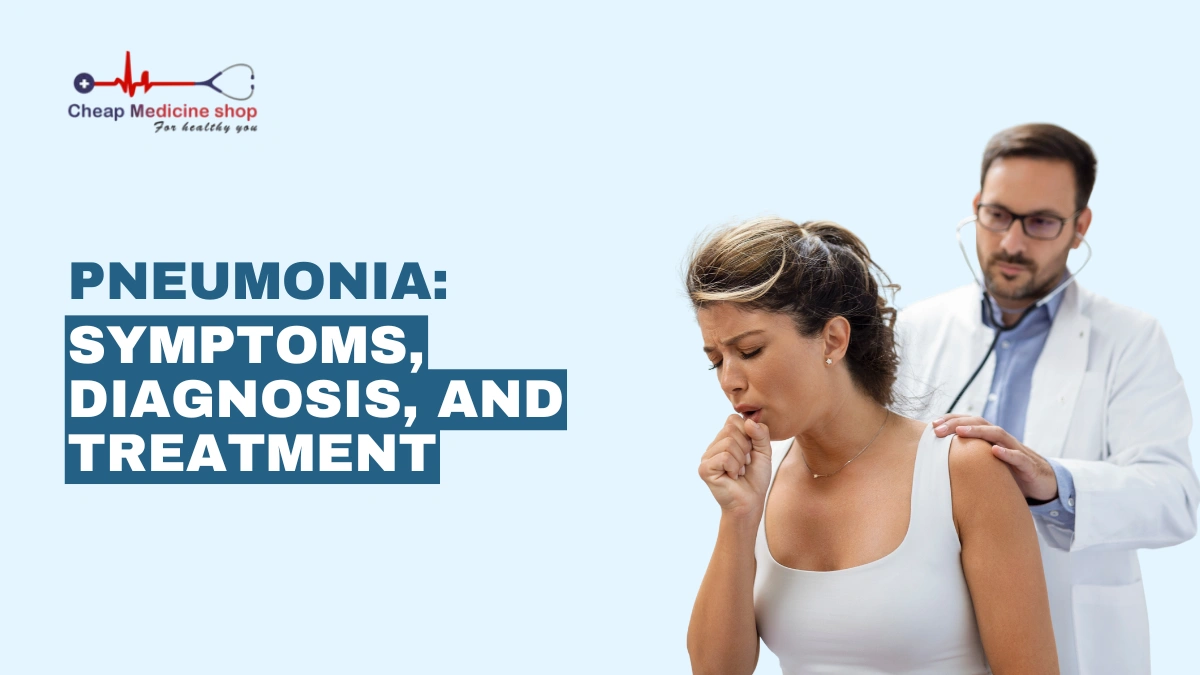Pneumonia is an infection that causes inflammation and fluid build-up in the lungs. The illness can be mild or severe, most commonly caused by bacteria, viruses, or fungi. This infection can affect anyone, from children to adults, but those under 5 or over 65 are more likely to be affected.
According to the report published by the United Nations International Children’s Emergency Fund (UNICEF) in 2024, Pneumonia results in the death of around 2000 children under the age of 5 every day. However, most of these are preventable with awareness and treatment.
Knowing the symptoms, risks, causes, and treatments of this lung infection is vital for spotting it early and treating it effectively. This article will cover all you need to know about this lung infection to protect yourself and the people around you.
What is Pneumonia and its symptoms?
It is an infection that affects one or both lungs, including one or all of the lobes (subdivisions of the lungs). The infection inflames air sacs in the lungs and may cause pus or fluid buildup.
Pneumonia symptoms can present differently in kids and adults, but some are very common for all, such as:
- Cough with green, yellow, or bloody mucus
- High fever (102 degrees Fahrenheit or above) and chills
- Vomiting
- Shortness of breath
- Chest pain when coughing or breathing deeply
- Fatigue or tiredness
- Sweating or cold, clammy skin
- Loss of appetite
- Confusion, especially in older adults
- Headache or muscle ache
Save up to 90% on your medicine bills

Azax 500 mg

Doxycycline Capsule

Azee 250 mg

Oseflu 75 mg
What causes this lung infection?
Pneumonia is usually classified based on the organisms that cause it, mainly bacteria, viruses, and fungi. Each group includes several species that affect the lungs in various ways. Knowing these categories and common organisms helps diagnose and guide effective treatment plans because what works for one pathogen does not work for the other.
Bacterial causes
Bacteria are the leading cause of Pneumonia in adults and children. Streptococcus pneumoniae is the most common bacterial cause of this infection. Other important types are Mycoplasma pneumoniae, Haemophilus influenzae, Staphylococcus aureus, and Legionella pneumophila.
Viral causes
Many viruses can cause Pneumonia, often following a cold or flu. Common viral pathogens include the Influenza virus, Respiratory Syncytial Virus (RSV), rhinoviruses (common cold), coronaviruses such as SARS-CoV-2 (COVID-19), adenoviruses, and parainfluenza viruses. Viral infection tends to be more common in young children and older adults.
Fungal causes
Fungal Pneumonia is rarer and usually affects people with weakened immune systems. Fungi like Histoplasma capsulatum, Coccidioides immitis, Cryptococcus neoformans, and Pneumocystis jirovecii are common causes and are found in specific geographical regions or environments.
What are its types?
Besides the main classification based on the pathogen that causes the lung infection, it can also be classified by how you get it and the lung area affected. These distinctions include:
Origin-based
Based on where or how the infection is acquired, it can be classified as:
- Community-acquired: This infection starts outside hospitals, often after a cold or flu.
- Hospital-acquired: This respiratory infection develops during a hospital stay, with a higher risk of antibiotic-resistant germs.
- Ventilator-associated: This happens in patients using ventilators for breathing support in hospital settings.
- Aspiration Pneumonia: This occurs when food, saliva, or stomach acid is inhaled into the lungs, often affecting people with swallowing difficulties or impaired consciousness.
Severity-based
Based on how severe the symptoms are or the impact of the infection, it can be classified as:
- Walking Pneumonia: This is a mild form, in which people do not need bed rest and can still do daily activities with symptoms like a cough and mild fever. It’s common in older kids and young adults.
- Complicated Pneumonia: This occurs when a standard infection leads to additional health issues or does not resolve easily. Complications can include pleural effusion (fluid buildup around the lungs) and lung abscesses (pockets of pus inside lung tissue).
Location-based
Based on the part of the lung affected, it can be classified as:
- Interstitial Pneumonia: This type of infection inflames the tissues around the air sacs of the lungs.
- Double Pneumonia: This infection is bilateral, which means it affects both lungs simultaneously.
- Lobar Pneumonia: This type affects an entire lung lobe, and symptoms may appear suddenly.
- Bronchopneumonia: This includes scattered patches throughout both lungs, often with more gradual symptoms.
Risk factors
Some people are more likely to get infected or have a severe outcome from the lung infection. Sometimes, even lifestyle and environment can increase the risk of getting infected. A few of these risk factors include:
- Age over 65 or under 5
- Chronic illnesses (heart disease, Diabetes, Asthma or Chronic Obstructive Pulmonary Disease)
- Weak immune system due to some conditions(Human Immunodeficiency Virus, Cancer treatments, organ transplant)
- Smoking or heavy alcohol use
- Recent cold, flu, or respiratory infection
- Living in crowded places or hospitals
How is it diagnosed?
To diagnose Pneumonia, doctors use several tools and tests. The options usually include:
- A clinical history and symptoms review, including questions about cough, fever, and breathing problems.
- Physical exam, where doctors listen for crackles or wheezing in the lungs.
- Chest X-ray, which shows infected or inflamed lung areas.
- Blood tests to check for infection and measure oxygen levels.
- A sputum (mucus) test to help find which bacteria, virus, or fungus is present.
- Pulse oximetry (a simple finger test to measure blood oxygen levels).
- CT scan or bronchoscopy in complicated or unclear cases.
Pneumonia treatment
Your doctor will decide on the best treatment after considering the underlying cause and severity of the lung infection. Some of the options include:
- Antibiotics: Amoxicillin or Azithromycin are the most commonly prescribed antibiotics for Pneumonia. Ceftriaxone or Doxycycline may be used for hospital-acquired infections.
- Antivirals: Oseltamivir may help with viral cases, like Influenza. Ribavirin and Adobiravir are also prescribed for some cases.
- Antifungals: Fluconazole or Amphotericin B are effective in the case of fungal respiratory infections.
- Supportive care: Resting, drinking extra fluids, and taking medicines like Acetaminophen or Ibuprofen for fever and pain are additional ways to support recovery.
- Oxygen therapy: This may be needed if oxygen levels are low or breathing is difficult.
- Hospitalization: People with severe infection, high-risk children, or those with complications may need hospital care for intravenous fluids, stronger medicines, or breathing support.
How to prevent it?
Preventing Pneumonia involves several effective strategies that reduce your risk of getting infected and promote overall lung health:
- Get vaccinated: Vaccines protect against several bacteria and viruses that cause infection. Important vaccines include pneumococcal vaccines (PCV13 and PPSV23), Influenza (flu) vaccine, Haemophilus influenzae type B (Hib), and COVID-19 vaccines. Young children, older adults, and those with certain risk factors should prioritize vaccination.
- Practice good hygiene: Washing hands with soap and water or using alcohol-based hand sanitizers can prevent the spread of germs. Cover your mouth and nose when coughing or sneezing to avoid spreading infections.
- Avoid contact with sick people: When possible, avoid individuals who have respiratory infections, and encourage them to maintain hygiene for recovery.
- Maintain a healthy lifestyle: Eating balanced meals, getting enough rest, avoiding smoking, exercising regularly, and managing chronic conditions all strengthen the immune system.
- Improve indoor air quality: Keep living areas clean, well-ventilated, and free from tobacco smoke or other pollutants that can weaken respiratory defenses.
- Manage existing illnesses: Following medical advice and treatment plans can reduce the chances of infection in the case of chronic respiratory conditions such as Asthma.
Conclusion
Pneumonia is a lung infection classified based on the pathogen that causes it, the part of the lung it affects or where you get it. It usually causes symptoms like fever, chills, and cough.
Although it is a common infection that can sometimes be severe, it can be managed with treatment and the best care.
Early diagnosis is possible with tests like blood tests or X-rays. Treatment with specific antibiotics or antivirals, such as Amoxicillin, Azithromycin, or Oseltamivir, helps defeat infection and prevent complications. Prevention is possible with good hygiene, vaccination, and attention to high-risk individuals.
You should always see a doctor quickly for chest pain, breathing trouble, or confusion, as these can be signs of severe infection that needs urgent care. Taking simple steps and seeking timely help ensures a safe, healthy recovery.
Frequently Asked Questions
Is Pneumonia contagious?
Yes, most cases caused by bacteria or viruses are contagious before treatment starts. It can spread through coughing, sneezing, or close contact. However, fungal and aspiration infections are not contagious.
How long is the recovery from Pneumonia?
It generally takes 1-2 weeks to start feeling better after starting treatment. However, the fatigue can last for a month. Complete recovery can take several months, and the time differs for each individual.
What’s the fastest way to recover from Pneumonia?
There is no single fastest way. Most people recover fast with rest, fluids, and taking all prescribed medicines, which differ depending on the type of infection. Following your doctor’s advice, eating healthy, and avoiding smoking or alcohol can speed up recovery.
Can Pneumonia come back after treatment?
Yes, it can return, especially if you have a chronic illness, weakened immunity, or did not finish your prescribed medicine. It is best to manage hygiene and strengthen your immunity to avoid recurrent infections.
What are the common complications of Pneumonia?
Common complications of Pneumonia include Lung Abscess (a pus-filled lung cavity), Pleural Effusion (fluid around the lungs), and Sepsis (the body’s extreme reaction to an infection). The risk is higher for young children (under 5), seniors (above 65), or people with other diseases.
Cheap Medicine Shop only refers to credible, authoritative sources for our content. If you’re curious about how we ensure the integrity of our content, we encourage you to read our Content Information Policy.














